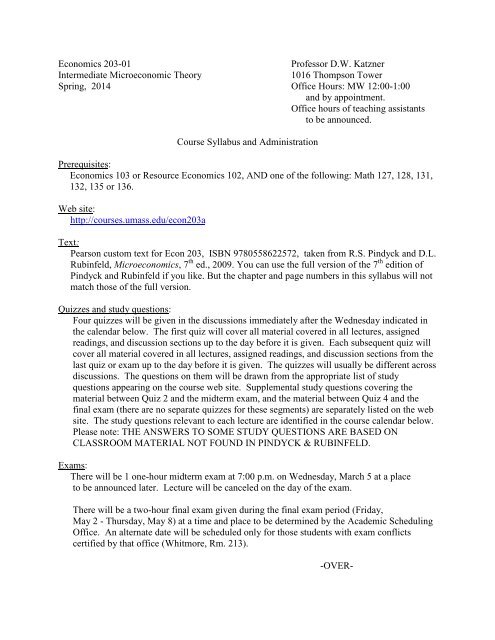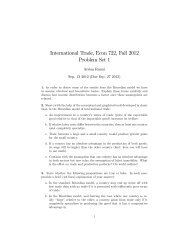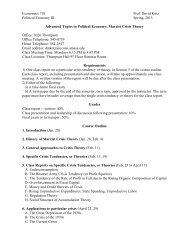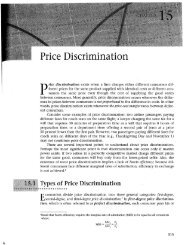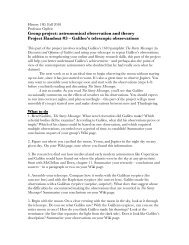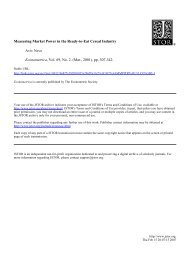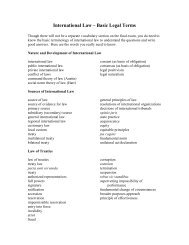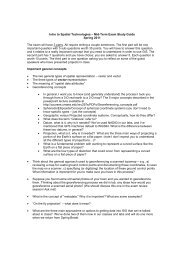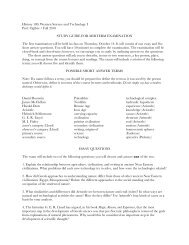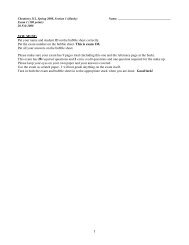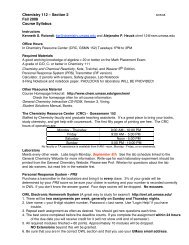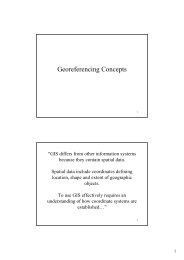You also want an ePaper? Increase the reach of your titles
YUMPU automatically turns print PDFs into web optimized ePapers that Google loves.
Economics 203-01Professor D.W. KatznerIntermediate Microeconomic Theory1016 Thompson TowerSpring, 2014 Office Hours: MW 12:00-1:00and by appointment.Office hours of teaching assistantsto be announced.<strong>Course</strong> <strong>Syllabus</strong> and AdministrationPrerequisites:Economics 103 or Resource Economics 102, AND one of the following: Math 127, 128, 131,132, 135 or 136.Web site:http://courses.umass.edu/econ203aText:Pearson custom text for Econ 203, ISBN 9780558622572, taken from R.S. Pindyck and D.L.Rubinfeld, Microeconomics, 7 th ed., 2009. You can use the full version of the 7 th edition ofPindyck and Rubinfeld if you like. But the chapter and page numbers in this syllabus will notmatch those of the full version.Quizzes and study questions:Four quizzes will be given in the discussions immediately after the Wednesday indicated inthe calendar below. The first quiz will cover all material covered in all lectures, assignedreadings, and discussion sections up to the day before it is given. Each subsequent quiz willcover all material covered in all lectures, assigned readings, and discussion sections from thelast quiz or exam up to the day before it is given. The quizzes will usually be different acrossdiscussions. The questions on them will be drawn from the appropriate list of studyquestions appearing on the course web site. Supplemental study questions covering thematerial between Quiz 2 and the midterm exam, and the material between Quiz 4 and thefinal exam (there are no separate quizzes for these segments) are separately listed on the website. The study questions relevant to each lecture are identified in the course calendar below.Please note: THE ANSWERS TO SOME STUDY QUESTIONS ARE BASED ONCLASSROOM MATERIAL NOT FOUND IN PINDYCK & RUBINFELD.Exams:There will be 1 one-hour midterm exam at 7:00 p.m. on Wednesday, March 5 at a placeto be announced later. Lecture will be canceled on the day of the exam.There will be a two-hour final exam given during the final exam period (Friday,May 2 - Thursday, May 8) at a time and place to be determined by the Academic SchedulingOffice. An alternate date will be scheduled only for those students with exam conflictscertified by that office (Whitmore, Rm. 213).-OVER-
2Students will be required to present their University identification cards when turning inall exams.Grading:Each quiz is worth 25 points, the midterm exam 100 points, and the final exam 200 points,for a total of 400 points. <strong>Course</strong> grades will be determined by adding the scores achieved onthe 4 quizzes and midterm exam to the score on the final exam. Incompletes will not begiven. A score of zero will be recorded for each quiz or exam missed.Exam coverage:Except as indicated below, the midterm exam will cover all material covered in all lectures,assigned readings, and discussion sections up to the day before it is given. The final examwill cover all material covered in all lectures, assigned readings and discussion sections forthe entire course. All questions on these exams will be drawn from the on-line studyquestions (described above) and the on-line problem sets (described below). At least onequestion from the study questions and one question from the problem sets will appear oneach exam. The relevant on-line study questions for the midterm exam consist of those forQuizzes 1 and 2 along with the supplemental study questions for the midterm exam. Therelevant study questions for the final exam consists of all study questions posted on line. Itshould be emphasized that although there will be considerable overlap between materialcovered in lectures, assigned readings, and discussion sections, there will also be materialarising uniquely in each format which will not appear in the remaining two.Exercises:Students are encouraged to work on the problems relating to non-excluded material at the endof the chapters of the text. Additional sets of problems appear on the course web site. Someof these latter problems are related to and build on each other. The solutions to all web-siteproblems are also available on the course web site. Although students will not be asked toturn in their own solutions to any of the problems, some exam questions, as noted above, willbe drawn from the on-line problem sets. The on-line problem sets relevant to each lectureare identified in the course calendar below.Suggestions for study:There are a total of 91 study questions and 69 questions in the on-line problem sets. Many ofthese questions have several sub-parts. All together, the questions number well over 200.About half are relevant for the midterm exam. It is not possible to learn all of the relevantcourse material well enough to answer most of these questions the day or even the weekbefore an exam. I would therefore suggest the following study strategy:(1) Before each lecture, read the relevant material for that lecture as indicated in thecourse calendar. Although the discussion in the book may often seem different fromwhat you hear in the lecture, your exposure to the ideas in advance will make it mucheasier to follow the lecture.(2) After each lecture, write down answers to the study questions that have been coveredin that lecture and work through the relevant parts of the problem sets (both areindicated in the course calendar). In doing these things, by all means collaborate with
3other students in the class if you have the opportunity.Following this strategy will make it much easier to study for the exams and is likely to resultin a better grade.Communicating by E-mail:I try to check for electronic messages every day. But on many days I am too busy to do so.Also, if there are a larger number of messages, it may take several days to respond to themall. You may receive a quicker response by communicating with me in person – afterlectures or during my office hours. Also, I will not respond by e-mail to questions you askabout course material that you do not understand. Such questions are usually either toovague (requiring my asking several questions to ascertain the difficulty you are having) ortoo complicated (perhaps requiring the drawing of a graph) to answer in the confined spaceof an e-mail message. When you need help understand something, please ask the teachingassistants or me in person.Excluded material:The following material from the assigned chapters in the text will not appear on any quiz,midterm, or final exam in this course. Although chapter numbers are not provided in the textitself, the chapter numbers below identify chapters in the order in which they appear.Chapter Topics Excluded from Exams Pages1 Real Versus Nominal Prices 10-132 Examples 3, 4 28-312 Understanding and Predicting the Effects… 47-563 Example 2 79-803 Example 4 89-903 Revealed Preference 90-933 Examples 6, 7 95-983 Cost of Living Indexes 98-1034 Network Externalities 134-1384 Empirical Estimation of Demand 138-1424 Appendix 147-155-OVER-
46 Example 3 194-1966 Production with Two Outputs 210-2136 Dynamic changes in Costs 213-2186 Estimating and Predicting Costs 218-2226 Appendix 226-2327 Example 5 251-2527 Producer Surplus in the Long Run 259-2607 The Effects of a Tax 264-2657 Long run Elasticity of Supply 265-2678 Factor Markets with Monopsony Power 289-2938 Factor Markets with Monopoly Power 293-2989 Gains from Trade 323-32810 A Rule of Thumb for Pricing 340-34210 The Effect of a Tax 343-34510 The Multiplant Firm 345-34710 The Rule of Thumb for Pricing 349-35210 Monopsony 359-36210 Monopsony Power 362-36711 The Cournot Model 386-38911 The Linear Demand Curve 389-39111 First Mover Advantage 391-39211 Price Competition 392-39711 Competition Versus Collusion 397-400
512 Recycling 432-43512 Stock Externalities 435-44112 Common Property Resources 445-447<strong>Course</strong> calendar:Reading (Ch.) andOn-LineStudy Question Quizzes and On-LineDate Lecture Topics (SQ.) Assignments Problem AssignmentsW, 1/22 1. Introduction Ch. 1SQ. 1.1a, 1.1b, 1.2, 1.3No discussions this week.M, 1/27 2. Basic mathematics Ch. 1W, 1/29 3. Demand, supply, Ch. 2SQ. 1.1c - 1.1g, 1.1p,1.1q, 1.3 - 1.7M, 2/3 4. Elasticity Ch. 2 I, parts 1a - 1e, 2 - 4SQ. 1.1r - 1.1z, 1.8, 1.9W, 2/5 5. Preferences, utility, Ch. 3indifference curves SQ. 1.1h - 1.1o,1.10 - 1.15Discussions Quiz 1M, 2/10 6. Budget constraints, Ch. 3utility maximization SQ. 2.1a, 2.1h, 2.2-2.4W, 2/12 7. Demand functions & Ch. 4 II, all parts;their properties SQ. 2.1b - 2.1c, III, parts 1, 22.5 - 2.9M, 2/17 Holiday: no lectureTu, 2/18 8. More properties of Ch. 4 III, parts 3 - 6demand functions, SQ. 2.1d - 2.1g,consumer surplus 2.10 - 2.13-OVER-
6W, 2/19 9. Factor supplies, pp. 281-284, IV, all partsproduction Ch. 5SQ. 2.1i - 2.1l,2.14 - 2.17Discussions Quiz 2M, 2/24 10. Production functions, Ch. 5 V, all partsisoquants, ridge lines SQ. 2*.1a - 2*.1g,2*.2 – 2*.4W, 2/26 11. Returns to factors Chs. 5, 6 VI, parts 1 - 4and scale, cost SQ. 2*.1h - 2*.1s,minimization,2*.5 - 2*.7aexpansion paths,cost functions (long run)M, 3/3 12. Cost functions (short Ch. 6 VII, all parts& long run) SQ. 2*.1t - 2*.1zc, VIII, all parts2*7b - 2*.9W, 3/5 13. Midterm exam: no lectureM, 3/10 14. Revenue, profit Ch. 7 VI, parts 5, 6maximization SQ. 3.1a, 3.1j, IX, all parts3.2 - 3.8 X, all partsW, 3/12 15. Output supply & Ch. 7 VI, part 7input demand SQ. 3.1b, 3.1c, 3.1h, I, part 1ffunctions, short-run 3.10 - 3.11output supply curves,producer surplusM, 3/24 16. Short run input Ch. 8 VI, part 9demand curves, SQ. 3.1d, 3.9,long-run equilibriumW, 3/26 17. Long run output Chs. 7, 8 VI, part 8supply & input SQ. 3.1e - 3.1g, 3.1idemand, economic 3.12 - 3.18rentDiscussions Quiz 3
7M, 3/31 18. The perfectly Ch. 9competitive economy, SQ. 4.1ageneral equilibriumW, 4/2 19. Consumption Ch. 9 XI, all partsEdgeworth box, SQ. 4.1b, 4.1c, 4.2, 4.3aPareto optimalityM, 4/7 20. Production Ch. 9 XII, all partsEdgeworth box, SQ. 4.1d - 4.1f, 4.3b,production 4.3c, 4.4possibilities, ParetooptimalityW, 4/9 21. Nonwastefulness, Ch. 9unbiasedness, SQ. 4.1g - 4.1j, 4.5 - 4.7utility possibilitiesM, 4/14 22. Welfare maximization, Ch. 9market failure SQ. 4.1k - 4.1p, 4.8 - 4.11Discussions Quiz 4W, 4/16 23. Monopoly, monopoly Ch. 10 XIII, all partspowerSQ. 4*.1a, 4*.1b,4*.2 - 4*.8M, 4/21 Holiday: no lectureW, 4/23 24. Monopolistic Ch. 11competition, SQ. 4*.1c, 4*.9 - 4*.11oligopoly 1M, 4/28 25. Oligopoly Ch. 11 XIV, all partsSQ. 4*.12 - 4*.15W, 4/30 26. Externalities, Ch. 12public goodsSQ. 4*.1d - 4*.1l4*.16 - 4*.211 The reference to the prisoner’s dilemma on p. 400 may be ignored.


